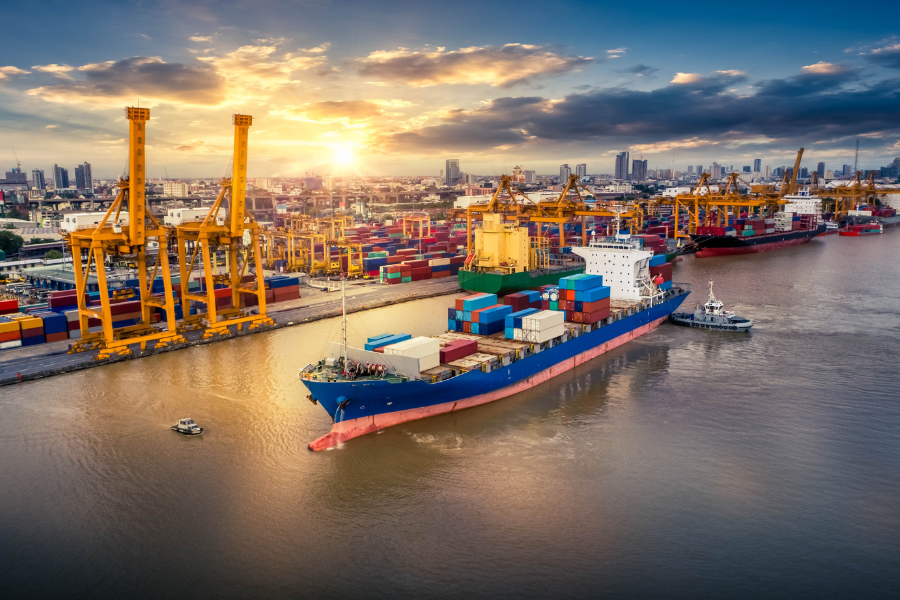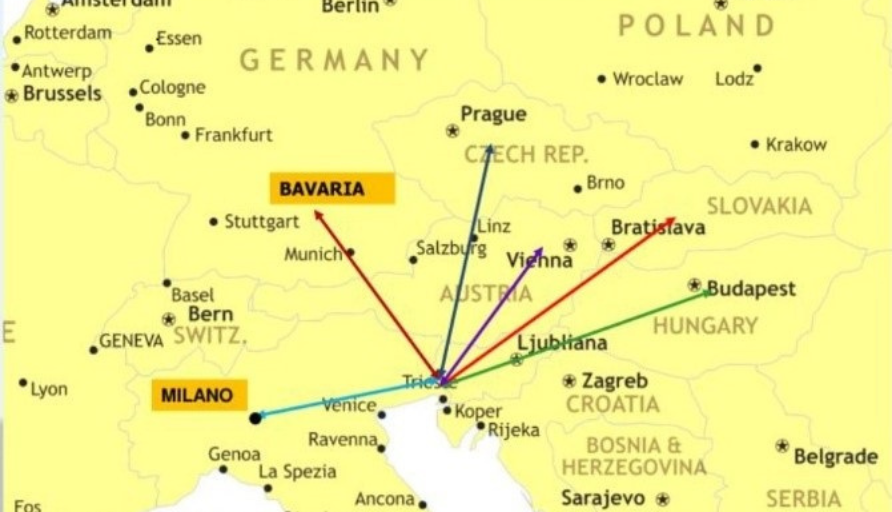Leverage Italian Ports for Boosting Fruit Export to Europe
India is the second largest producer of fresh fruits, but its exports to European Union (EU) are negligible. To raise our exports to the region by 2 to 3 times by 2030, India should consider Italian ports for exporting products to Central Europe. This will help exporters save a minimum of 4-5 days of sailing time along with advantage of fast transit within 24 hours from port to markets in Austria, Germany, Czech Republic etc. which are distant from Rotterdam or Antwerp ports.

Image Credit: Shutterstock
The ports of Rotterdam, Antwerp and Hamburg corner the major import of tropical fruits into the EU. The total import of fresh fruits (HS 08) in EU was over $60 billion in 2021. Though India is the second largest producer, its exports to EU are negligible. The 2021 EU import of some of the major Indian produce are as follows:
| Product | EU Imports | India Exports to EU | India Production Rank | India Export Rank to Europe |
| Banana | $6.1bn | $712mn. | 1 | 45 |
| Grape | $4.6bn. | $256mn. | 7 | 7 |
| Mango | $1.46bn. | $22mn. | 1 | 14 |
| Pomegranate | $973mn. | $10mn. | 1 | 18 |
Overall, our EU export rank is 24, which is below many emerging nations such as Vietnam, Costa Rica, Ecuador, Egypt and Ivory Coast. So, is it possible to raise our fruit exports to EU substantially? Yes! we can.
Both Rotterdam and Antwerp ports are the biggest re-exporter of fruits, especially banana, mango and grapes. In total, 8 million tonnes of fresh fruit and vegetables arrive in the Netherlands every year, and 11 million tonnes depart the country. Of the fresh fruit and vegetables arriving in the Netherlands, not even 20% is meant for the domestic market.
There are two main reasons for India’s poor performance in EU markets. One is our high Minimum Residual Limits (MRL) for agricultural products. However, continued growth of re-export shows that many emerging countries seem to have adopted EU’s tough MRL conditions. We can take cold comfort from the fact that one of our competitors, Turkiye which has a customs union with EU has seen the largest contamination alerts in fresh fruit & vegetable.
The exporters in South America are able to meet MRL as the banana is grown in large company plantations managed by multinationals such as Chiquita, Del Monte & Dole. They can enforce quality of the product. In contrast, in India, banana is grown by millions of small farmers and the quality of the fruit, harvesting & packaging can only improve with large-scale government intervention.
Our exports of grapes suffered due to high MRL some years back but since then, with the introduction of GRAPENET traceability system, our exports are rising again but can still do better.
With the new MRL imposed by EU which is 0.01 mg/kg means that the product must be near organic in quality. I would not be surprised if non-organic products are banned in the next few years. We must be ready and willing to take steps to increase export of organic fruits.
The second reason is India’s long distance to the major importing ports of Rotterdam and Antwerp. The sailing time from JNPT to Rotterdam or Antwerp is 15 days while to Hamburg is 17 days.
Indian exporters should consider Italian ports for exporting the above products to Central Europe, besides Italy. The exporters will save at least 4-5 days of sailing time and also take advantage of fast transit within 24 hours from port to markets in Austria, Germany, Czech Republic, Poland, Slovakia etc. which are distant from Rotterdam or Antwerp ports.
Over the past decade, the banana trade has been fast-moving to almost full containerization. Advances in temperature-controlled containers have allowed the international banana trade to be transported long distances in hard, green, unripe condition, which is later ripened in the country of consumption.
Strategically located in the northernmost point of the Mediterranean Sea at the heart of Europe, easily accessible overland across fast road and rail connections and by sea across the ultra-large container vessels which can dock in the ports’ natural deep-water, the Ports of Genoa and Trieste as gateway to the major consumer centres in Europe. The industrial heartland of Europe sits within a 600-km range of the ports: Switzerland, Bavaria, Baden-Wurttemberg, Austria.
These ports are premier logistics hub for tropical fruit and fresh produce, thanks to wide state-of-the-art storage facilities offering any kind of value-added logistics services to perishable cargo prior to onward final destination. A selection of full-container and multipurpose terminals offer extensive dedicated facilities equipped with reefer plugs which guarantee the fast and meticulous handling of reefer containers for maximum freshness, serving Italy and Southern Europe. These ports benefit from a strategic position with easy access to/from the major inland routes, both by road across the international motorway network and by rail to major industrial destinations, including direct on-terminal connections along the Rhine-Alpine Corridor, with capacity upgrades due to be completed soon. The fruits can reach their destination faster, cheaper and in good condition for supermarkets in Central Europe.
Using this strategy, exporters would avoid strong competition from South American countries, forge new relationship with distributors and bulk buyers increasing their export value year by year.
For decades, the banana economy has been one of the key examples of power concentration in the hands of a few multinational companies such as Chiquita. More recently, the growing market power of retailers and competition between large fruit companies to remain their ‘preferred suppliers’ has led banana chains to be increasingly driven by supermarkets, notably in Europe.
Since the beginning of 2010, a consortium of European civil society organisations have been campaigning under the banner ‘Make Fruit Fair’ to raise awareness on the social and environmental issues related to banana (and pineapple) production and trade. Since Indian fruits such as banana, pineapple, mango and grapes are grown by small landholders and not large plantations owned by multinationals. Indian export organisations such as Apeda should make common cause with such activist organisations like “Make Fruit Fair” to promote Indian produce.
According to K. Unnikrishnan, Joint Director General of FIEO, India can reach at least $500 million exports within five years to grab a 3% share in global trade and be one of the top 10 exporters if it improves production, post-harvest handling and phytosanitary standards.
Globally, bananas are exported entirely by sea-freight. However, in India, more than 60% is exported through air. This costlier mode restricts marketability of Indian bananas. There is a need for closer association with major shipping lines as well as foster close trade association with major Italian distributors and European retail chains.
With uncertainty looming over major agricultural exports such as rice, cotton etc. due to climate change and fulfilling domestic needs, the country should develop alternate product groups as well as new destinations. Fruits can substitute these commodities and we should aim to raise our exports to EU 2 to 3 times by 2030.
The article is authored by Suhayl Abidi, Consultant, Centre for VUCA Studies, Amity University and Research Advisor, Govt. of Guj-AMA Centre of International Trade















Very good article